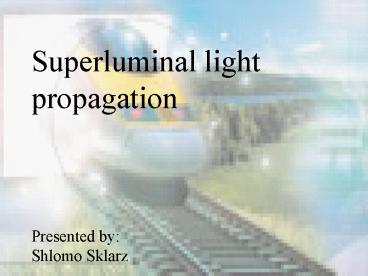Superluminal light propagation - PowerPoint PPT Presentation
1 / 14
Title:
Superluminal light propagation
Description:
1) Light propagation & Group velocity- basic concepts. ... Wang Experiment: [L.J. Wang et al. Nature 406 (2000) p277] Cesium. Gas Cell. 0.2ns. 6cm ... – PowerPoint PPT presentation
Number of Views:214
Avg rating:3.0/5.0
Title: Superluminal light propagation
1
Superluminal light propagation Presented
by Shlomo Sklarz
2
Outline of talk 1) Light propagation Group
velocity- basic concepts. 2) Effects of
dispersion on group velocity. 3) Experimental
realization. 4) Conformation with relativity and
causality.
3
Fundamentals
- Electromagnetic Wave Equation
- Fourier decomposition
Frequency components
Wave packet
4
Dispersive media
- In dispersive mediaPolarization occurs in
linear response to field - Dispersion relation
- Dispersion frequency components experience
different refractive index values.
5
Phase velocity vs. Group velocity
Contribution only where phase is slowly varying
6
Group Velocity
- We assume for simplicity no absorption or gain.
(n is real) - When n is linear in ?, a pulse propagates without
distortion. - Various regimes1) In vacuum 2) Normal
dispersion3)Anomalous dispersion4)
Negative group velocity
7
Negative Group velocity
- Pulse exits medium before(!) entering.
- Within an anomalous dispersion medium longer wave
lengths appear shorter. - Medium facilitates rephasing.
8
Wang Experiment L.J. Wang et al. Nature 406
(2000) p277
Cesium Gas Cell
Probe pulse
0.2ns 6cm
3.7?s 1.1km
9
Results
- No pulse shape distortion.
- Negative velocity of -c/310.
- Peak travels 20m (62ns) out of cell before
incoming pulse enters.
10
Problem How do these results conform with our
common notions of relativity and causality?
?
11
Solution Sharp distinction between
A. Sommerfeld L. Brillouin (1914) wave
propagation and group velocity
- Signal velocity
- Motion of sharp signal front.Physical meaning.
- Sharp fronts imply contribution from all
frequency components. - No physical medium can achieve anomalous
dispersion over all frequencies.
- Group velocity
- Motion of pulse peak.Geometrical meaning.
- Gaussian peaks - infinite tails.
- Leading front carries information about coming
pulse. - Medium amplifies leading wing to reconstruct
following pulse
12
No true superlminal signal motion Leading front
of pulse is amplified at expense of tail to
achieve advancement of peak center.
13
So where is the trick?
Sharp wave front discontinuity travels at
vc. Packet peak is shifted forwards, and so
travels at vgtc.
14
- Conclusions
- Dispersive media can alter the group velocity of
a light pulse - The Group velocity can be lower, equal to, or
higher than the speed of light and even negative. - These effects have been realized experimentally.
- This is not at odds with relativity since
information is carried by the signal velocity of
the pulse.































